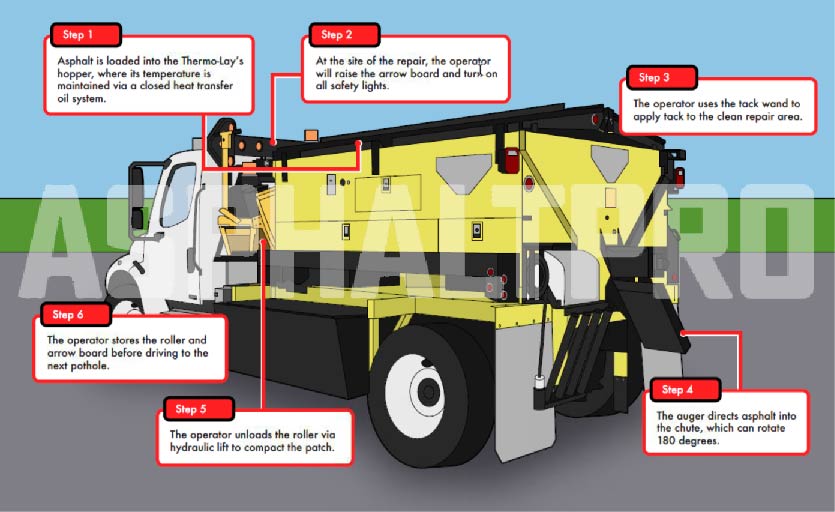Thermo-Lay Manufacturing’s Pothole Patching Machine
BY AsphaltPro Staff

Here’s how Thermo-Lay’s truck-mounted pothole patching machine works.
Leaving a pothole unpatched not only opens that pavement to further water penetration, but it can also be a liability for the agency in charge of that road. The Thermo-Lay truck-mounted pothole patching machine from Thermo-Lay Manufacturing LLC, Billings, Montana, aims to solve both of those problems. Here’s how it works.
Asphalt is loaded into the Thermo-Lay’s hopper, where its temperature is maintained via a closed heat transfer oil system with one propane burner and one electric heater. Digital thermostats read the temperature of the asphalt and regulate day and night temperatures.
Although monitored by a separate thermometer, the same heat transfer oil that heats the asphalt also maintains the tack oil temperature via a copper bypass, to prevent its temperature from exceeding the temperature set for the mix.
On the jobsite, the operator will raise the arrow board approximately 36 inches above the truck and engage all safety lighting. The arrow board is visible from as close as 10 feet behind the truck to as far as 2 miles in daylight.
Any asphalt collected while cutting off or cleaning the repair area can be placed in the Thermo-Lay’s two bins, each more than one cubic yard. Once the repair area is clean and free of debris, the operator can use the tack oil wand to tack the area. This acts as a base coat or primer for the repaired area.
A two-speed auger motor directs the asphalt into the chute, which pivots 180 degrees to angle the asphalt directly into the pothole at rates up to two cubic yards per minute. The motor starts out at high speed, low torque and will automatically shift down to low speed, high torque when the motor senses the need for more torque.
When it’s time to compact the repair, the operator uses the hydraulic lift to unload the vibratory roller from behind the cab. The Thermo-Lay can accommodate a variety of brands of vibratory rollers and plate compactors. Depending on customer preference, the placement of the hydraulic lift could instead be at the rear of the machine. When the roller is returned to the lift and stored, it is automatically locked. The operator will lower the arrow board before driving to the next pothole location.
Once the day’s repairs are complete, the operator can pull a lever housed on the right rear of the machine to switch from tack oil to cleaning fluid and clean the system. The operator will also flip a switch to clean or lubricate the hopper with a 25-second blast of biodegradable release agent, coating the entire inner surface. The bins on each side can be dumped hydraulically.
For more information, contact Brian at (406) 259-9525 or brian@thermo-lay.com.
